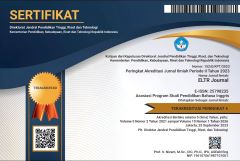DEVELOPING MULTIMEDIA TECHNOLOGY FOR EFL CLASSROOMS IN INDONESIA USING ADDIE MODEL: A LITERATURE REVIEW
Abstrak terlihat: 1355 / PDF terunduh: 1082DOI:
https://doi.org/10.37147/eltr.v7i1.162Keywords:
ADDIE model, curriculum and instructional design, EFL, multimediaAbstract
Most academic learning situations involve multimedia learning since students encounter words and graphics, ranging from multimedia encyclopedias to online educational games to textbooks. Multimedia has become increasingly used to help learning and cognition. As technology advances, educators are required to be more creative when creating learning devices. Teachers and lecturers need to develop an instructional design that can address the needs of the students. ADDIE model is one of the most effective tools in developing educational products and other learning resources, including multimedia technology. This paper attempts to explore how multimedia in various levels of EFL classrooms in Indonesia are developed using the ADDIE model in particular. Nationally accredited articles were categorized based on similar themes to multimedia development using ADDIE model to be analyzed. Most of the articles showed a successful development and implementation of the media used in teaching reading, listening, writing vocabulary, and language functions. The multimedia: worksheets, websites, applications, cards, and videos, are mostly rated highly by the expert. The validity and practicality were also high. However, some of the articles did not mention the principles and details of the process of multimedia development.
Downloads
References
Branch, M. B. (2010). Instructional design: The ADDIE approach.
Bulan, A., & Idhar, I. (2021). Developing noun words domino card (NWDC) learning media to improve English vocabulary mastery of junior high school students. VELES Voices of English Language Education Society, 5(2), 192–205. https://doi.org/10.29408/veles.v5i2.4028
Dong, H. (2021). Adapting during the pandemic: A case study of using the rapid prototyping instructional system design model to create online instructional content. Journal of Academic Librarianship, 47(3), 102356. https://doi.org/10.1016/j.acalib.2021.102356
Furwana, D., & Syam, A. T. (2021). “Listening is hard”: ADDIE model on the development of English listening worksheets. Language Circle: Journal of Language and Literature, 16(1), 52–60. https://doi.org/10.15294/lc.v16i1.30355
Irawan, Y. (2021). Developing multimedia-based English listening material for Islamic senior high school. Ta’dib, 24(1), 1-8. https://doi.org/10.31958/jt.v24i1.2033
Lajoie, S. P. (2014). Multimedia learning of cognitive processes. The Cambridge Handbook of Multimedia Learning, Second Edition, May, 623–646. https://doi.org/10.1017/CBO9781139547369.031
Li, Y., & Zhai, Q. (2011). Analysis of deficiencies and countermeasures of using computer multimedia in English teaching. Advances in Intelligent and Soft Computing, 108, 141–147. https://doi.org/10.1007/978-3-642-24775-0_22
Mayer, R. E. (2014a). Cognitive theory of multimedia learning. The Cambridge Handbook of Multimedia Learning, Second Edition, May, 43–71. https://doi.org/10.1017/CBO9781139547369.005
Mayer, R. E. (2014b). Introduction to multimedia learning. The Cambridge Handbook of Multimedia Learning, Second Edition, 1–24. https://doi.org/10.1017/CBO9781139547369.002
Nadiyah, R. S., & Faaizah, S. (2015). The development of online project based collaborative learning using ADDIE model. Procedia - Social and Behavioral Sciences, 195, 1803–1812. https://doi.org/10.1016/j.sbspro.2015.06.392
Pinter, A. 2017. Teaching young language learners. Oxford: Oxford University Press.
Prensky, M. (2001), Digital natives, digital immigrants part 1. On the Horizon, 9(5), 1-6.
Pun, M. (2014). The use of multimedia technology in English language teaching: A global perspective. Crossing the Border: International Journal of Interdisciplinary Studies, 1(1), 29–38. https://doi.org/10.3126/ctbijis.v1i1.10466
Purwanti, I. T., Prawati, A., & Aruan, R. R. (2022). Developing educational videos containing authentic interaction video clips for teaching language functions. EDUKATIF: Jurnal Ilmu Pendidikan, 4(4), 5582–5594.
Rahman, N. S., & Hermayawati, H. (2019). Designing a comicqu application for VIII graders’ reading – Writing Assessment. JELE: Journal of English Language and Education, 5(2), 83–90.
Sari, N., Mirizon, S., & Inderawati, R. (2021). Developing learning media of recount texts for vocational high school students. English Review: Journal of English Education, 9(2), 263–276.
Setiawan, H. (2021). Developing interactive multimedia for teaching reading comprehension on narrative texts based on South Sumatera local culture. IDEAS: Journal on English Language Teaching and Learning, Linguistics and Literature, 9(2), 632–641. https://doi.org/10.24256/ideas.v9i2.2161
Sopian, S., Inderawati, R., & Petrus, I. (2019). Developing e-learning based local-folklores for eighth graders. English Review: Journal of English Education, 8(1), 101. https://doi.org/10.25134/erjee.v8i1.1813
Suprianti, G. A. P. (2020). Powtoon animation video: A learning media for the sixth graders. VELES Voices of English Language Education Society, 4(2), 152–162. https://doi.org/10.29408/veles.v4i2.2536
Wiiphasith, H., Narumol, R., & Sumalee, C. (2016) The design of the contents of an e-learning for teaching M.5 English language using ADDIE model. International Journal of Information and Education Technology, 6(2), 127-131. https://doi.org/10.7763/IJIET.2016.V6.671
Zaim, M., Refnaldi, R., & Elfiona, E. (2020). Developing mobile based authentic listening materials for senior high school students. Ta’dib, 23(1), 1-10. https://doi.org/10.31958/jt.v23i1.1794
Downloads
Published
How to Cite
Issue
Section
License
Copyright (c) 2022 Annisa Hafizah Gamal

This work is licensed under a Creative Commons Attribution-ShareAlike 4.0 International License.













